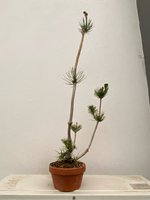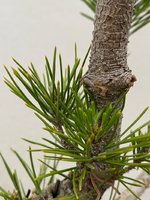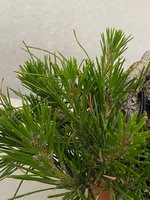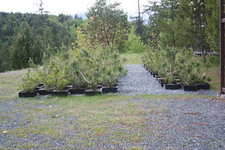The approach I have been taught is very close to
@River's Edge 's advice.
At this stage, if I had the same tree (the weaker of the two brothers), I'd have a very similar sacrificial leader in terms of size/height, however, it wouldn't have been slowed down at the tippy-top the way this one has been. It would instead be "poodled with a never-interrupted solo'd-out leader at top". In other words, when I decandle a tree like this, I don't decandle that tip shoot.
Re: "poodle" jargon: The sacrificial would be kept very bushy at the tip and stripped of needles and shoots almost (more on "almost everything" below) everywhere
else along the sacrificial trunk (hence "poodle"). At the top, just one big singular tip shoot as Frank suggests rather than multiple tips (but I don't chase those extra tips down as they appear, I let them mature and produce for the tree for some time). Fewer auxin emitters at a sacrificial tip seem to help the "keep/future-tree region" of the tree continue to progress (as opposed to regress) while still helping with thickening, root development, budding elsewhere on the tree, wound closing, and any repots that might have to happen. Gary Wood also suggested that the
sheer distance between the poodle's tip and the rest of the tree also helps decouple the influence of the poodle from the rest of the tree. I've done some digging in the literature and it does seem that the auxin signal diminishes with distance. The sugar produced at that tip still manges to migrate down to the rest of the tree though.
At Hagedorn's, I've been taught to shoot select and/or chop (depending on where the tree is at) the big sacrificial tip at roughly leaf drop time (give or take a number of weeks depending on how big your work backlog is). Others vary in their timing/reduction approach and get similar or competent results too though. For example Ryuchi Kitadani (in the youtube video linked above) seems to do it at a completely different time of the year (spring + summer). Also, while Kitadani aggressively solos out (selects down to 1 tip shoot) his poodles, Hagedorn will instead keep
several mega-shoots up there before reducing -- Both seem to get great results in development goals (thickening, wound-healing, root development, wound-closing). Both seem to not lose what they want to keep down in the retain-region. One critical difference between Kitadani and Hagedorn though is that most of Hagedorn's JBPs that I've seen or worked on are not shohin or even close to shohin. The solo'ing out seems to be more common the smaller the target size is. I study under Andrew Robson as well (some of his JBP training coming from apprenticing under Hagedorn) and his shohin JBPs tend to have more solo'd out, single leader poodles. The bigger the target tree size, the crazier the tip sacrificial is, and the less the retain region seems to mind even while being aggressively decandled. Anecdotally-speaking.
In terms of selection/solo timing, I personally justify keeping the surplus top shoots until leaf drop time with the argument that I want to get whatever current-year productivity I can get before selecting them out, so I never remove these when they're still fresh, however, I have sometimes felt compelled to select out the extras at a non-leafdrop time if I feel like I'm about to lose valuable/useful tiny/weak branches far below (if working at shohin scale). YMMV depending on climate and myriad other horticultural factors.
Regarding "strip almost everything other than the poodle tip itself", I have tried to keep at least 1 extra not-too-strong shoot somewhere half way up to the poodle -- in your picture, this'd be a single small shoot located at that group of needles half way up. This gives me something to "step down to" and maintain at least a little bit of sap flow right after chopping away the poodle. The hope being that anything that is proximate to the base of the sacrificial leader (and/or weak) doesn't die off after that chop. This is an approach I got from Jonas Dupuich and seems to help with the transition. I decandle that step-down shoot to keep it from becoming leader-like unless I'm anticipating a near-term poodle chop.





















